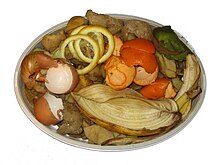Collection

In areas where the waste collection is a public function, food waste is usually managed by the same governmental organization as other waste collection. Most food waste is combined with general waste at the source. Separate collections, also known as source-separated organics, have the advantage that food waste can be disposed of in ways not applicable to other wastes. In the United States, companies find higher and better uses for large commercial generators of food and beverage waste.
From the end of the 19th century through the middle of the 20th century, many municipalities collected food waste (called "garbage" as opposed to "trash") separately. This was typically disinfected by steaming and fed to pigs, either on private farms or in municipal piggeries.
Separate curbside collection of food waste is now being revived in some areas. To keep collection costs down and raise the rate of food waste segregation, some local authorities, especially in Europe, have introduced "alternate weekly collections" of biodegradable waste (including, e.g., garden waste), which enable a wider range of recyclable materials to be collected at reasonable cost, and improve their collection rates. However, they result in a two-week wait before the waste will be collected. The criticism is that particularly during hot weather, food waste rots and stinks, and attracts vermin. Waste container design is therefore essential to making such operations feasible. Curbside collection of food waste is also done in the U.S., some ways by combining food scraps and yard waste together. Several states in the U.S. have introduced a yard waste ban, not accepting leaves, brush, trimmings, etc. in landfills. Collection of food scraps and yard waste combined is then recycled and composted for reuse.
Comments
Post a Comment